June 6, 2002
Contacts:
Alan MacRobert, Senior Editor
855-638-5388 x151, [email protected]
Roger W. Sinnott, Senior Editor
855-638-5388 x146, [email protected]
Note to Editors/Producers: This release is accompanied by several illustrations; see details below.
Solar eclipses are grand, cosmic events that no nature-watcher wants to miss — and an opportunity to see one will occur over much of the United States and Canada this Monday, June 10th.
This will be only a partial eclipse, which won't be as spectacular as a total one. The Sun will never be completely blackened by the Moon crossing in front of it, and daylight will dim by only a trace. But the eclipse will still provide a powerful celestial spectacle — for those who know how to watch it safely.
Those in the West and northern Plains states will have the best view (weather permitting), because the eclipse happens while the Sun is still well up in the western sky. Across much of the Midwest and South, the eclipse will be in progress at the time of sunset, affording a beautiful "crescent Sun" on the horizon. Only the East misses out completely.
In the zones where the eclipse is visible, the farther south you are the better. Canadians will see only a fairly small dent appearing in one side of the Sun, but in the Southwest and northern Mexico, the Sun will turn into a dramatic, narrow crescent.
The eclipse will last anywhere from less than a half hour (where interrupted by sunset) to three hours. You'll need to know when the eclipse begins, reaches its maximum, and ends for your location. Below is a timetable for a few large U.S. metropolitan areas. Times for more than 300 cities in North America are available in our larger table.
| Partial Solar Eclipse of June 10, 2002 Calculations by Roger W. Sinnott, Sky & Telescope |
||||||
| Location | Eclipse begins |
Eclipse midpoint |
Alt. | Mag. | Obs. | Eclipse ends |
| Chicago, IL | 7:28 p.m. CDT | 8:10 p.m. | 2° | 30% | 19% | (sunset) |
| Dallas, TX | 7:27 p.m. CDT | 8:22 p.m. | 2° | 58% | 48% | (sunset) |
| Minneapolis, MN | 7:26 p.m. CDT | 8:08 p.m. | 7° | 29% | 18% | 8:48 p.m. |
| Albuquerque, NM | 6:22 p.m. MDT | 7:22 p.m. | 10° | 63% | 54% | 8:16 p.m. |
| Denver, CO | 6:21 p.m. MDT | 7:16 p.m. | 12° | 51% | 40% | 8:08 p.m. |
| Phoenix, AZ | 5:19 p.m. MST | 6:23 p.m. | 13° | 72% | 65% | 7:21 p.m. |
| Los Angeles, CA | 5:13 p.m. PDT | 6:22 p.m. | 19° | 77% | 71% | 7:23 p.m. |
| San Francisco, CA | 5:06 p.m. PDT | 6:16 p.m. | 24° | 72% | 65% | 7:19 p.m. |
| Seattle, WA | 5:02 p.m. PDT | 6:04 p.m. | 28° | 48% | 37% | 7:00 p.m. |
| Honolulu, HI | 1:04 p.m. HST | 2:42 p.m. | 60° | 52% | 41% | 4:06 p.m. |
In the table, Alt. is the altitude of the Sun above the horizon at maximum eclipse, the depth of which is expressed two different ways: magnitude ("Mag.") denotes how far the Moon will bite into the Sun's diameter, while obscuration ("Obs.") denotes how much of the Sun's disk area will be covered.
Elsewhere in the world, the partial eclipse will also be visible across most of the Pacific Ocean, in Japan, much of China, the Philippines, and parts of Indonesia and north-central Australia. At locations west of the International Date Line the event happens on the morning of June 11th.
The eclipse will be annular — with the Sun briefly seen as a thin, brilliant ring of light — along a narrow track crossing the Pacific and touching land only at Tinian, Saipan, and a bit of the Mexican coast just south of Puerto Vallarta. For further information see the detailed article about the eclipse.
During a partial eclipse, some of the bright Sun remains in view. Warning: You should never look at the Sun — partially eclipsed or not — without proper eye protection (such as specially filtered eclipse glasses)! Staring at the bright Sun can burn your retina, leaving a permanent blind spot in the center of your vision. A partial eclipse poses a special danger only in that it can prompt people to look directly at the Sun, something they wouldn't normally do. See our complete descriptions of the various ways to watch safely.
People who've never tried photographing a solar eclipse before can get fine results following Sky & Telescope's tips for photographers.
Sky & Telescope is making the following illustrations available to the news media. Permission is granted for one-time, nonexclusive use in print and broadcast media, as long as appropriate credits (as noted in each caption) are included. Web publication must include a link to SkyandTelescope.com.
Click on each image (or follow instructions in the caption) to download a high-resolution version.
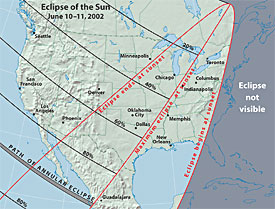
Most North Americans living west of the Mississippi River will see a partial solar eclipse on June 10th (west of the International Date Line: June 11th). On the East Coast, the Sun will set before the eclipse occurs. Black lines indicate the fraction of the Sun's diameter that will be covered at maximum eclipse.
Sky & Telescope illustration.
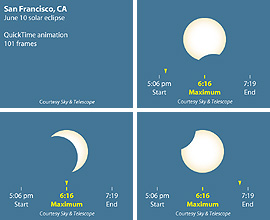
Each city in North America will witness June 10th's partial eclipse differently, with times and shapes unique to its location. Broadcast-quality QuickTime animations are available to view or download for the following cities; note that the files are typically 3 to 5 megabytes in size: Chicago, Columbus, Dallas, Denver, Indianapolis, Los Angeles, Memphis, Minneapolis, New Orleans, Oklahoma City, Phoenix, San Francisco, Seattle, and Toronto.
Sky & Telescope animation by Steven Simpson and Roger W. Sinnott.

June 10th's partial solar eclipse will occur at various times and look quite different, depending on your location across North America. The frame shown here is for 6:15 p.m. PDT (7:15 p.m. MDT, 8:15 CDT). A Flash animation is available for viewing or download: PC version, Mac version.
Sky & Telescope: Larry Koehn.
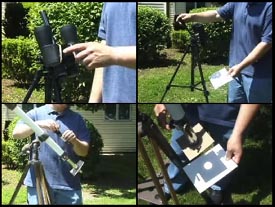
It's not safe to observe the Sun with unprotected eyes or through sunglasses — no matter how dark they are. Nor is it safe to Sun-gaze through binoculars or a telescope unless equipped with a full-aperture solar filter. Two video clips (TRT: 23.00 and 29.00; no audio) show the proper way to project the Sun's image onto a white card using either a pair of binocular or a small telescope. These can be viewed or downloaded as QuickTime movies, either as low resolution (3.5 megabytes) or as broadcast-quality high resolution (207 megabytes) via FTP.
Sky & Telescope video.
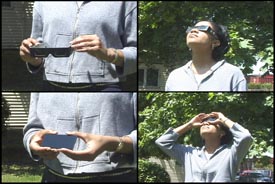
It's not safe to observe the Sun with unprotected eyes or through sunglasses — no matter how dark they are. Nor is it safe to Sun-gaze through binoculars or a telescope unless equipped with a full-aperture solar filter. Two video clips (TRT: 13.00 each; no audio) show the proper use of specially filtered 'eclipse' glasses and a #13 or #14 welder's glass. These can be viewed or downloaded as QuickTime movies, either as low resolution (2.2 megabytes) or as broadcast-quality high resolution (102 megabytes) via FTP.
Sky & Telescope video.
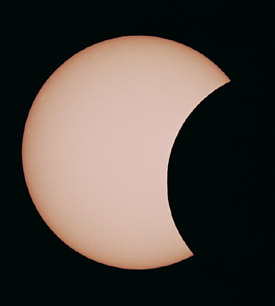
The annular eclipse of May 10, 1994, was seen along a narrow path across Mexico and the United States. However, virtually all North Americans with clear skies saw the Sun's disk at least partially covered by the Moon. This image was taken with an 8-inch Schmidt-Cassegrain telescope from Ogunquit, Maine.
Sky & Telescope: Richard Tresch Fienberg.
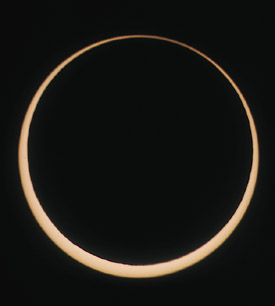
The annular eclipse of May 10, 1994, was seen along a narrow path across Mexico and the United States. This image was taken with an 8-inch Schmidt-Cassegrain telescope from Ogunquit, Maine.
Sky & Telescope: Richard Tresch Fienberg.
 0
0
Comments
You must be logged in to post a comment.